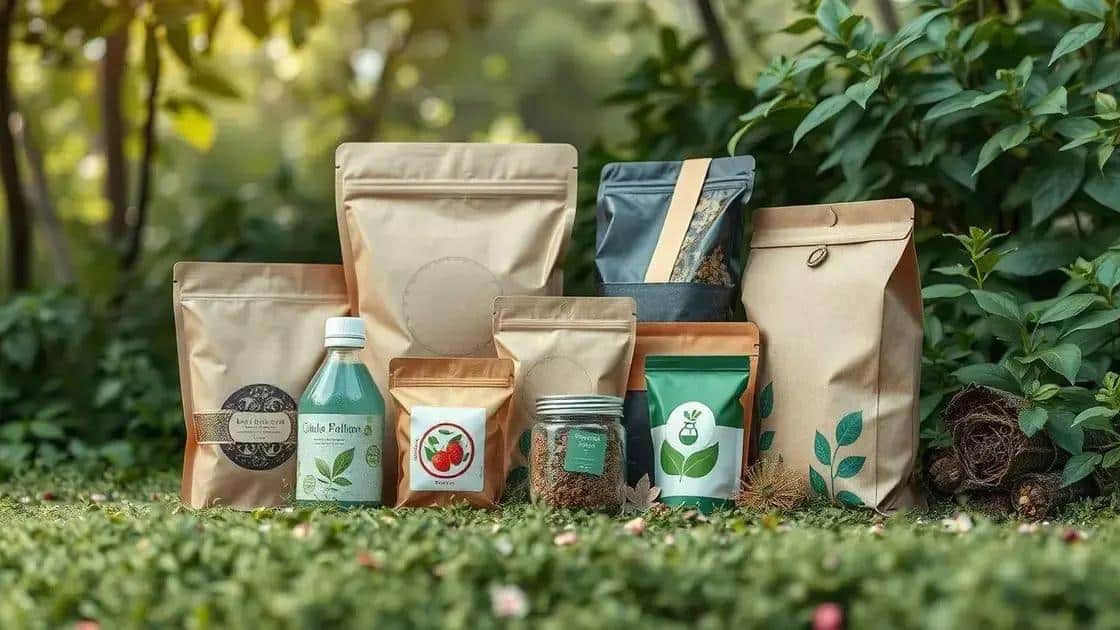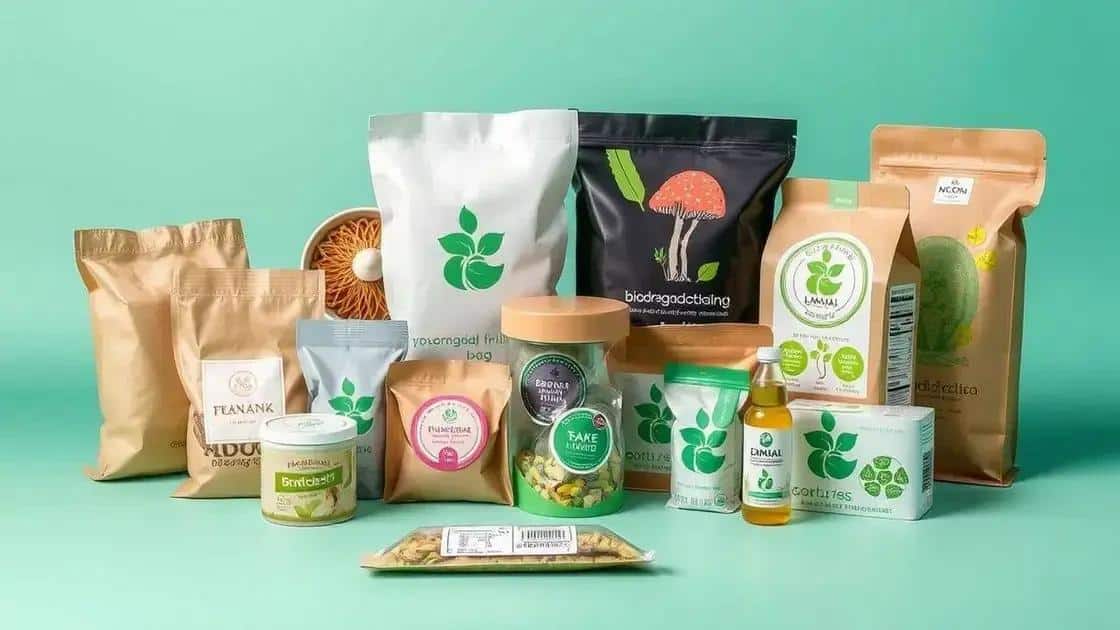Sustainable packaging news insights: latest trends to watch

Sustainable packaging news insights show that brands adopting eco-friendly materials and practices can reduce waste, enhance consumer trust, and meet the growing demand for environmentally responsible products.
In the world of eco-conscious habits, sustainable packaging news insights are crucial for businesses and consumers alike. Have you ever wondered how packaging affects our environment? Let’s explore the latest advancements in this field.
Understanding sustainable packaging
Understanding sustainable packaging is essential in today’s environmentally conscious market. This innovative approach focuses on reducing environmental impact while maintaining product integrity. As consumers become more aware of their choices, the demand for sustainable materials increases.
Key Features of Sustainable Packaging
Sustainable packaging includes several characteristics that set it apart from traditional packaging. These features aim to minimize waste and promote recycling.
- Biodegradable materials: Materials that decompose naturally, reducing landfill waste.
- Recyclable options: Packaging that can be processed into new products, conserving resources.
- Reduced material usage: Designing packages that use less material without compromising quality.
Furthermore, sustainable packaging often utilizes renewable resources, which can lower carbon footprints significantly. The emphasis on durable and eco-friendly designs encourages brands to rethink their packaging choices.
Benefits of Sustainable Packaging
Choosing sustainable options comes with various benefits. Companies that implement sustainable packaging practices can enhance their brand image and appeal to eco-conscious consumers. This approach not only helps the environment but can also lead to cost savings in materials and disposal. By investing in sustainable practices, businesses contribute positively to their communities and help drive the demand for eco-friendly materials further.
As we explore this topic, it becomes clear that sustainable packaging is not just a trend; it’s a vital part of our future. Embracing these practices will lead to a healthier planet and a sustainable economy.
Emerging trends in eco-friendly materials

Emerging trends in eco-friendly materials are reshaping the packaging industry significantly. Consumers increasingly seek products that demonstrate a commitment to sustainability. This demand pushes companies to innovate constantly.
New Materials on the Market
One trend gaining momentum is the development of bio-based materials. These come from renewable resources, such as plants and agricultural waste. They offer an alternative to traditional plastics.
- PLA (Polylactic Acid): A bioplastic made from corn starch that is both compostable and biodegradable.
- Mushroom packaging: Derived from fungi, this material is fully compostable and helps reduce plastic waste.
- Seaweed-based materials: Harnessing seaweed’s natural properties creates biodegradable packaging solutions that are sustainable.
Another exciting trend is the upcycling of waste materials. Companies are transforming discarded items into valuable packaging options. This not only reduces landfill waste but also promotes a circular economy.
Smart and Functional Packaging
Equally important, smart packaging integrates technology to provide added functionality. For example, some eco-friendly packages now include freshness indicators or QR codes that connect consumers to sustainability stories.
The rise of eco-friendly materials reflects a broader shift toward sustainable practices in various industries. Businesses recognizing this trend can lead the market, enhance their brand, and appeal to a growing base of environmentally aware consumers.
Consumer preferences and sustainable choices
Consumer preferences and sustainable choices are becoming increasingly intertwined. Today’s shoppers are more aware of their impact on the environment, driving the demand for eco-friendly products. This change reflects a growing concern for our planet’s health and future.
What Influences Consumer Choices?
Several factors influence consumer decisions when selecting sustainable options. One major factor is awareness. Many consumers actively seek out information on sustainable packaging and responsible brands. Social media plays a critical role in spreading awareness and educating individuals about their purchasing power.
- Brand transparency: Brands that communicate their sustainability efforts clearly attract more customers.
- Product certifications: Eco-labels and certifications boost consumer confidence, showing that products meet specific environmental standards.
- Price: While some consumers are willing to pay more for sustainability, others still view cost as a significant barrier.
Moreover, personal values strongly affect buying behavior. Consumers who prioritize environmental protection are more likely to choose eco-friendly materials over traditional options.
Shifting Market Trends
As awareness increases, businesses must adapt to shifting market trends. Companies that align their products with consumer preferences for sustainable practices stand to benefit. Offering sustainable alternatives not only appeals to eco-conscious buyers but can also enhance brand loyalty.
With the rise of online shopping, consumers can easily compare sustainability efforts among brands. This ease of access empowers shoppers to make informed decisions that align with their values. Furthermore, the influence of social media continues to heighten demand for transparency in sustainable practices.
Case studies on successful sustainable packaging

Case studies on successful sustainable packaging illustrate how brands are making significant changes in their operations. These examples show that adopting eco-friendly practices can boost brand reputation and reduce environmental impact.
Company A: Reducing Plastic Waste
Company A transitioned from traditional plastic bags to biodegradable options. This decision led to a 30% reduction in plastic use within one year. Their customers loved the change, leading to increased sales and improved customer loyalty.
- Impact: Reduced carbon footprint and enhanced public image.
- Strategy: Engaged customers through marketing campaigns highlighting their commitment to sustainability.
Moreover, their packaging is now made from sustainable materials, which aligns with the values of modern consumers.
Company B: Innovative Materials
Company B adopted mushroom packaging for their products. This eco-friendly alternative is made from agricultural waste and decomposes naturally. Their commitment to using renewable resources has garnered media attention, significantly boosting their visibility.
As a result, consumers are more willing to support brands prioritizing sustainability. The use of mushroom packaging not only meets customer demand for eco-friendly products but also draws eco-conscious consumers to the brand.
Company C: Transparency and Certification
Company C redesigned its packaging to feature transparent labeling. They obtained eco-certifications to back their claims. This approach builds trust with consumers who seek authenticity in the brands they support.
- Effect: Increased sales from a growing base of environmentally aware customers.
- Learning: Transparency leads to stronger customer relationships.
These case studies demonstrate that successful sustainable packaging strategies can positively affect business growth while fostering a commitment to environmental responsibility.
FAQ – Frequently Asked Questions about Sustainable Packaging
What is sustainable packaging?
Sustainable packaging is designed to minimize environmental impact by using eco-friendly materials and reducing waste.
Why should businesses adopt sustainable packaging?
Adopting sustainable packaging can enhance brand reputation, attract eco-conscious consumers, and reduce costs related to waste management.
What are some examples of eco-friendly materials?
Examples of eco-friendly materials include biodegradable plastics, mushroom packaging, and recycled cardboard.
How can transparency affect consumer choices?
Transparency about sustainability efforts builds trust with consumers, influencing them to choose brands that prioritize environmental responsibility.





